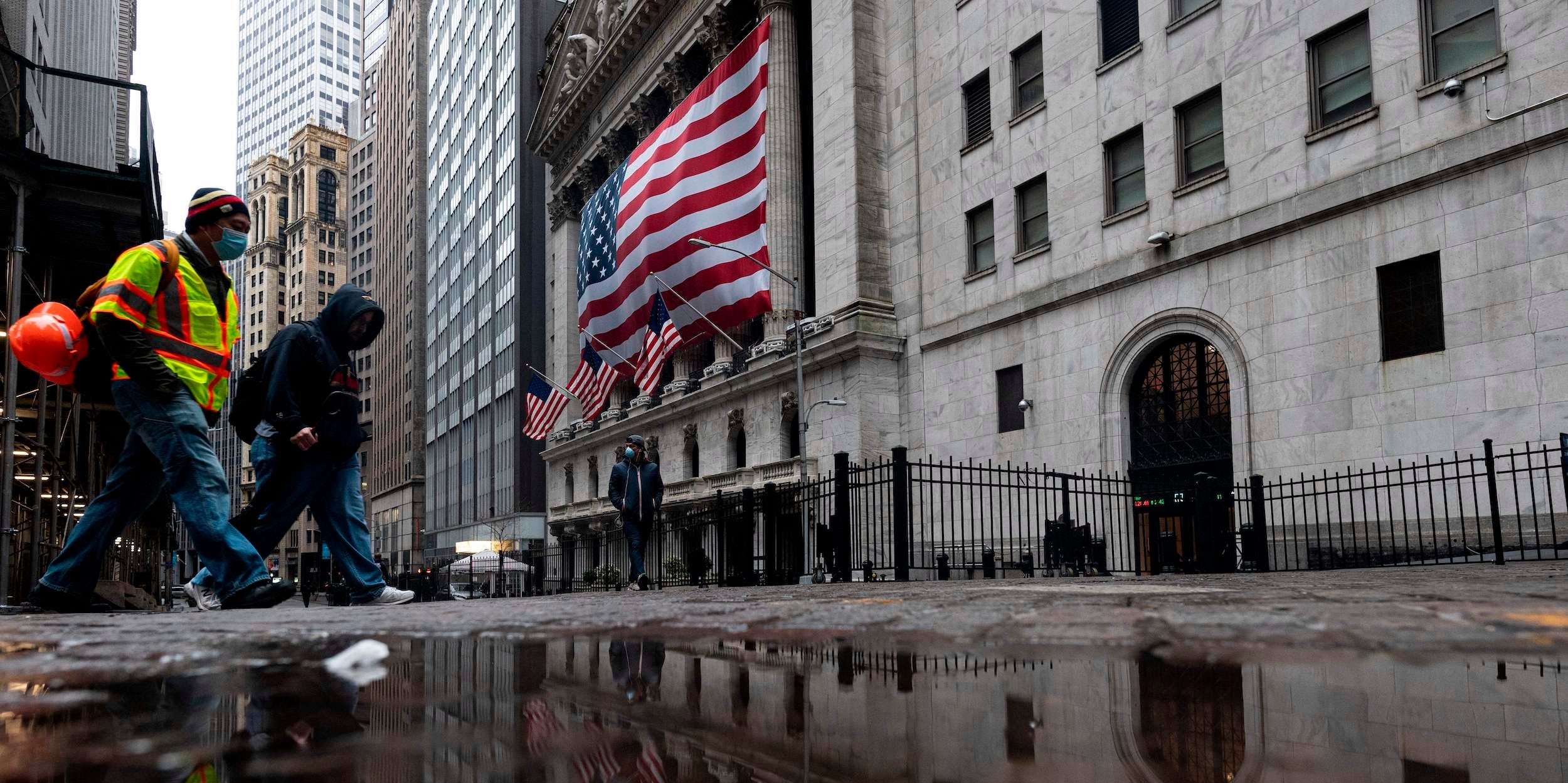
- Hopes for a fast recovery are lifting market volatility and threatening record highs in stocks.
- First it led to a rise in Treasury yields, making bonds more appealing than highly valued stocks.
- With inflation fears rising, investors are dumping tech stocks, weighing on major indexes.
- See more stories on Insider's business page.
The US stock market is at a turning point, and the economic recovery is probably why.
For investors holding last year's hottest stocks, a likely strong rebound in the economy isn't looking so welcome.
After tech giants drove indexes to record highs last year, the prospect of a full reopening has dented the sector's appeal. Investors began dumping Treasurys at a faster pace in February as the likelihood of a new stimulus package raised expectations for near-term inflation. Cash was pulled from defensive assets and pushed into stocks most likely to thrive during a reopening.
The rotation reached a crescendo on February 25. Investors began to price in that Democrats' $1.9 trillion stimulus package would boost spending and inflation expectations rose. As a result, market participants began to pull forward forecasts on when the Federal Reserve would slow its asset purchases and lift interest rates.
So began a new stage of the "reopening trade." Investors bracing for a return to pre-pandemic norms are aiming to capitalize on recoveries in the sectors hit hardest by the pandemic. At the same time, defensive assets that fared well over the past year are underperforming as traders move cash elsewhere.
The bond market reacted first. The 10-year Treasury yield rose above 1.6% for the first time in more than a year in late February as inflation fears swelled further. Stronger returns from Treasurys tend to dent the appeal of highly valued stocks, and the sudden leap in yields placed expensive tech stocks on the chopping block. Volatility spiked, cyclical stocks thrived, and growth favorites seen as practically invincible months earlier tumbled.
The trend has somewhat cooled as traders have been buying the dip in tech. But relief from fresh stimulus stands to accelerate economic growth and reignite violent swings throughout the market. The tech giants that fueled the market's last rally now have the most to lose.
Changing of the stock-market guard
Tech had its time in the sun. The group has had the strongest annual average return since 2007 of all 11 S&P 500 sectors and led the overall market in three of the last four years. Crowding in the FAANG coalition - Facebook, Apple, Amazon, Netflix, and Google-parent Alphabet - drew comparisons to the dot-com bubble, yet shares soared even higher.
The pandemic only lifted the coalition higher. The companies' relative insulation from the coronavirus' fallout pulled in even more investors. Tech giants became the go-to defensive play as the pandemic stretched on into the summer of 2020, the following fall, and then a dire winter resurgence. Each member of the FAANG group gained at least 30% through 2020, handily beating the S&P 500's 16% return.
That trend is starting to unwind. Non-tech firms' outlooks for economic growth have improved, with economists citing falling virus case counts, the improved rate of vaccination, and Democrats' massive new stimulus package for their stronger growth estimates. So-called reopening stocks that plummeted at the start of the pandemic quickly became market favorites.
The changing of the guard isn't likely to please equities investors, at least in the short term. The S&P 500 is heavily weighted in tech stocks, meaning an exodus from the sector's mega-caps is likely to drag the entire index lower. And while Treasurys have stabilized, their higher yields stand to pull cash out of stocks.
Where pandemic-era investing was as simple as parking cash in tech, it's now a tug-of-war between reopening hopes and inflation concerns, Mark Haefele, chief investment officer of global wealth management at UBS, said.
"We believe the recent equity volatility is likely to continue as investors seek to balance increasing optimism over [economic] growth with worries about higher inflation," he added.
The dueling outcomes - rampant inflation and healthy growth - mark a shift from the market's unidirectional path. Economists and strategists advised investors throughout the pandemic to stick to the market's safest names until COVID-19 was no longer a threat. Now, with investors seeing the light at the end of the tunnel, positioning isn't so simple.
That balance already emerged in investor surveys. More than 80% of investors surveyed by Bank of America this month cited higher rates and less dovish central banks as the biggest risk to stocks in 2021. That's up from 38% the month prior. Meanwhile, just 11% of respondents named a potential worsening of the pandemic as the biggest risk.
In other words, good news on vaccinations and reopening isn't necessarily good news for stocks.
Nothing to see here, folks
Fears of uncontrollable inflation and premature Fed tightening have a tight grip on the market, but strategists aren't as worried.
To start, Treasury yields remain at historically low levels. The 10-year yield stood close to 2% in the months before the pandemic and as high as 3.2% in the fall of 2018. And while the yields' ascent prompted concern, that climb has cooled off with Treasurys still trading at relative highs.
Precedent suggests rising yields aren't all that harmful to stocks, anyway. Since 1960, the market has endured 13 periods during which the 10-year yield rose at least 1.5 percentage points, according to analysis from LPL Financial. The S&P 500 rose during 10 of those 13 instances with an average annual gain of 6.4%.
The broader backdrop tends to play a major role in determining whether stocks can climb alongside rates, and LPL sees current dynamics permitting such a rally. Rising rates during times of high inflation historically resulted in lower stock returns, but inflation hasn't shown any signs of firming up. A recent steepening of the Treasury yield curve also suggests healthier equities gains are on the horizon, according to the firm.
"Every market environment is unique, but taking our cues from history, the economic fundamentals continue to look strong and the current rising rate picture looks most similar to those periods of above-average stock performance," said Barry Gilbert, asset allocation specialist at LPL.
Public officials have similarly played down concerns that inflation will hinder the economic recovery. Fed Chair Jerome Powell has repeatedly said that, while reopening could quickly lift inflation, such a rise is likely to be temporary. The central bank will "be patient" in waiting for inflation to steadily trend above 2% before it pulls back on its monetary stimulus, he added in a March 4 speech.
The amount of slack still in the labor market should also counter fears around inflation and an overheating economy, Treasury Secretary Janet Yellen said Monday.
"We had a 3.5% unemployment rate before the pandemic and there was no sign of inflation increasing," Yellen said.
Others are simply unsurprised by the market froth. Recovery rallies tend to give way to consolidation as interest rates rise and investors spread cash more evenly between growth and value names, Michael Wilson, chief US equity strategist at Morgan Stanley, said March 7. Everything taking place between the Treasury and stock markets "should be expected at this stage of a recovery," he added.
"The bull market continues to be under the hood, with value and cyclicals leading the way," Wilson said. "Growth stocks can rejoin the party once the valuation correction and repositioning is finished."










